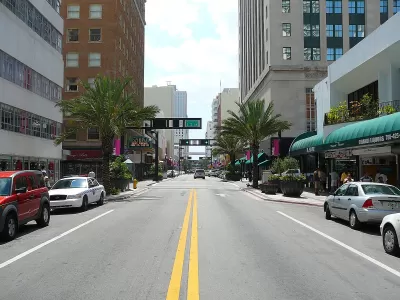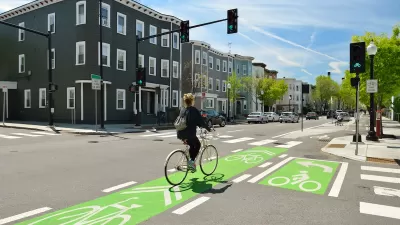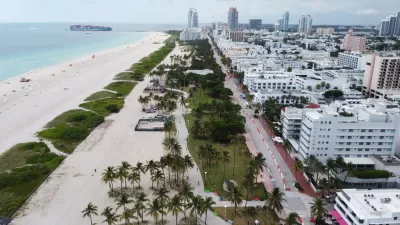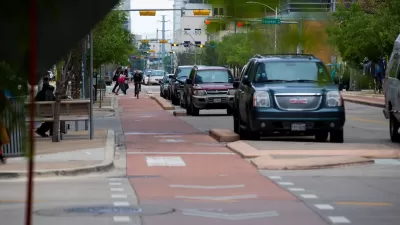The city, which has some of the nation's most dangerous streets for pedestrians and cyclists, is installing 3 miles of new bike lanes and pedestrian ramps on some of its busiest downtown corridors.

E-scooter fees will partially fund a $2 million program to add 3 miles of protected bike lanes in downtown Miami. As reported by Jason Plautz in Smart Cities Dive, "the city will install concrete barriers along the new lanes and add pedestrian ramps to adjacent sidewalks."
"The goal is to eventually build an extensive network of micromobility lanes — including bollards, concrete barriers and painted bike boxes — that would connect large parts of downtown, rather than simply adding lanes to a handful of streets, said Carlos Cruz-Casas, assistant director for mobility in the Miami-Dade County Department of Transportation and Public Works. The 'proactive' effort, he said, will help create 'a more inclusive transportation network' and also further the county’s Vision Zero goals, which seek to eliminate traffic deaths and serious injuries by 2030."
Kevin Amézaga, executive director of the mobility group Miami Riders Alliance, calls the new lanes "extremely necessary" given Miami's dangerous roads. "As scooters have become more popular and established transportation tools in cities, transportation departments around the country are rethinking their infrastructure plans to build dedicated lanes or paths that can accommodate them. Many cities — like Indianapolis, Atlanta and Santa Monica, California, — have required micromobility operators add fees or pay into infrastructure funds to pay for the new construction."
FULL STORY: E-scooter fees help fund protected bike lanes in downtown Miami

Study: Maui’s Plan to Convert Vacation Rentals to Long-Term Housing Could Cause Nearly $1 Billion Economic Loss
The plan would reduce visitor accommodation by 25,% resulting in 1,900 jobs lost.

North Texas Transit Leaders Tout Benefits of TOD for Growing Region
At a summit focused on transit-oriented development, policymakers discussed how North Texas’ expanded light rail system can serve as a tool for economic growth.

Why Should We Subsidize Public Transportation?
Many public transit agencies face financial stress due to rising costs, declining fare revenue, and declining subsidies. Transit advocates must provide a strong business case for increasing public transit funding.

How Community Science Connects People, Parks, and Biodiversity
Community science engages people of all backgrounds in documenting local biodiversity, strengthening connections to nature, and contributing to global efforts like the City Nature Challenge to build a more inclusive and resilient future.

Alabama: Trump Terminates Settlements for Black Communities Harmed By Raw Sewage
Trump deemed the landmark civil rights agreement “illegal DEI and environmental justice policy.”

Dear Tesla Driver: “It’s not You, It’s Him.”
Amidst a booming bumper sticker industry, one writer offers solace to those asking, “Does this car make me look fascist?”
Urban Design for Planners 1: Software Tools
This six-course series explores essential urban design concepts using open source software and equips planners with the tools they need to participate fully in the urban design process.
Planning for Universal Design
Learn the tools for implementing Universal Design in planning regulations.
City of Santa Clarita
Ascent Environmental
Institute for Housing and Urban Development Studies (IHS)
City of Grandview
Harvard GSD Executive Education
Toledo-Lucas County Plan Commissions
Salt Lake City
NYU Wagner Graduate School of Public Service





























